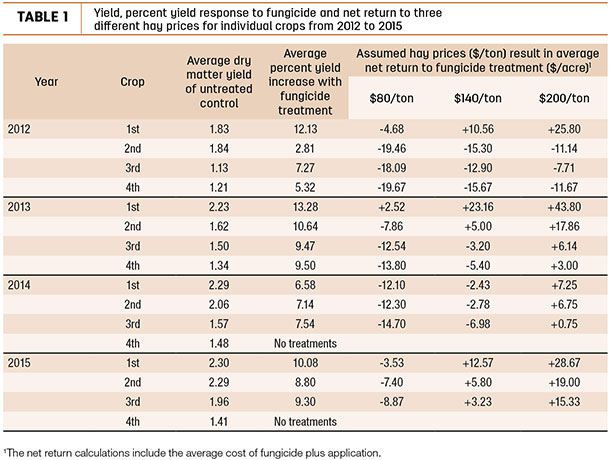The research evaluated best weather conditions, application timing and alfalfa varieties for foliar fungicide treatments when determining cost-effectiveness and yield response to fungicide treatments.
“Just as with fungicide applications for corn and soybeans, we need to select our opportunities with alfalfa as to where the probability of economic return is the greatest,” says Brian Lang, northeast Iowa field agronomist with ISU Extension and Outreach.
“To apply fungicides to alfalfa without much thought to harvest schedule or environmental conditions does not follow proper stewardship of pesticide use, nor would it result in maximizing profits.”
According to the research, here are best practices when using foliar fungicides in alfalfa production:
On average, the trials suggest that the first crop or cutting provided a higher percent yield response to a foliar fungicide application than for later crops.
Lang says three main factors contributed to this: Spring environments are usually more favorable for alfalfa diseases, yield potential for first crop is higher than for later crops, and the growth period for first crop is considerably longer than that of later crops.
Fungicide treatments applied during the extremely wet spring of 2013 resulted in some of the most profitable net returns for both the first and second crop.
Trials conducted during the summer of 2012 showed low disease incidence and only an average fungicide treatment yield response of about 5 percent.
The limited rainfall during the summer of 2012 and above-average temperatures is linked to the low yield response and resulted in a net loss in dollars per acre, even with hay priced at $200 per ton.
“This is a logical cause and effect, and strongly supports the notion and field experience of other researchers that foliar fungicide applications under dry climatic conditions are not profitable,” says Lang.
Yield per cutting plus yield response to fungicide plus hay price are all critical in contributing to profitability.
“A 10 percent yield increase from a fungicide application doesn’t add as much value to $80-per-ton hay as it would to hay priced at $200 per ton,” says Lang.
Table 1 indicates yield, percent yield response to fungicide and net return to three different hay prices for individual crops from 2012 to 2015.
 Targeting about a 5-inch canopy height for the second, third and fourth crop is advisable, while waiting for a 6- to 8-inch canopy is ideal for treating the first crop.
Targeting about a 5-inch canopy height for the second, third and fourth crop is advisable, while waiting for a 6- to 8-inch canopy is ideal for treating the first crop.
Some of the ISU trials compared timing of fungicide applications at a 3- to 4-inch canopy versus a 6- to 8-inch canopy. Since foliar fungicides only protect what they land on, an application to the 6- to 8-inch canopy should offer more protection.
Waiting for an 8-inch canopy height for second, third or fourth crop in a four-cut system could be problematic though, since these products have a 14-day pre-harvest interval.
“I suggest a compromise by targeting about a 5-inch canopy height for these applications. However, I still prefer the 6- to 8-inch canopy timing for treating the first crop,” says Lang.
The main reason to use foliar fungicides is to achieve increased yield, and producers should not necessarily count on increased forage quality.
It is reasonable to assume that if foliar fungicide applications reduce disease infestations, leaf retention may be improved and result in higher forage quality at harvest. To interpret forage quality differences in some of the ISU trials, subsamples were sent to forage testing labs.
Even though there was some visual evidence of better leaf retention, the forage quality analyses (calculated relative feed value) and milk per ton did not show significantly better forage quality test results with the vast majority of the fungicide-treated plots.
There are no industry standards in place to provide leaf disease ratings for alfalfa varieties to aid in the decision of foliar fungicide use in alfalfa production.
Some trials included two alfalfa varieties. Variety A averaged 14 percent lower in leaf disease incidence than variety B and yielded better than variety B in absence of a fungicide treatment, but both yielded the same when treated with a fungicide.
It is understandable that alfalfa varieties may have different tolerances to leaf diseases. However, re-stated again, there are no industry standards in place to provide leaf disease ratings for alfalfa varieties to aid in the decision of foliar fungicide use in alfalfa production. ![]()
PHOTO: The decision to use a fungicide or not, and the timing of use, affects net return. Brian Lang, Iowa State University agronomist, discusses research on fungicide use in alfalfa. Photo by Chris Geralds.
Jody Korthaus is a communications specialist, agriculture and natural resources, with Iowa State University Extension. Email Jody Korthaus.








